A Comparative Study of the Mode-Decomposed Characteristics of the Asymmetricity of a Vortex Rope with Flow Rate Variation
Abstract
:1. Introduction
2. Case Study Description
3. Setup of Computational Fluid Dynamics
3.1. Setup of Simulation
3.1.1. Fluid Domain
3.1.2. Turbulence Model
3.1.3. CFD Setup
3.2. Monitoring Points for DMD Data
4. Verification and Validation
4.1. Experimental–Numerical Comparison
4.2. Vortex Rope Flow Details
5. Dynamic Mode Decomposition (DMD)
5.1. Method of DMD
5.2. Results of Dynamic Mode Decomposition
5.2.1. The Case of vi = 0.85 m/s
5.2.2. The Case of vi = 1.7 m/s
5.2.3. The Case of vi = 3.4 m/s
6. Conclusions
- (1)
- The influence of flow rate or velocity on flow pattern is well known, but when there are rotating components its impact is reflected in the uncontrolled vortex flow downstream, and the specific magnitude of its impact still requires special qualitative or quantitative analysis. When the inlet flow velocity is vi = 0.85 m/s, a core forms in the vortex zone of the draft tube and the fluid rotates in the same direction around the lowest pressure point of the cross-section. The backflow phenomenon occurs in the low-pressure region. When the inlet flow velocity is vi = 1.7 m/s, a spiral vortex rope forms above the draft tube and a core forms below. The fluid still rotates in the same direction around the lowest pressure point of the section, and the backflow of the TP1 section is reduced. When the inlet flow velocity is vi = 3.4 m/s, there is a significant spiral vortex rope in the draft tube and the fluid at the TP1 section rotates in two directions, resulting in the disappearance of the backflow phenomenon in the flow field.
- (2)
- Fourier-transform analysis was performed on the high-energy modes decomposed from the DMD analysis, and the relative frequencies of the modes against the reference frequency were obtained as 0 (averaged), 0.7, and 1.4, respectively. The eigenvalues corresponding to the first mode are real numbers with a relative frequency of 0, indicating that the flow corresponding to this mode is time-averaged, representing the average flow mode of the velocity field. Due to the fact that the vortex rope is runner-driven and always undergoes periodic changes, its average feature is an important feature that is proved by this decomposition of a low-frequency conjugate mode with a relative frequency of 0.7, which is the low-frequency oscillation of the flow field superimposed on the basic structure. This component below the runner frequency is a representative pulsation frequency component of the vortex rope, and it is also the main motion law of the vortex rope found in the past. The feature extraction via mode decomposition was successful and correct. A high-frequency conjugate mode with a relative frequency of 1.4 refers to the high-frequency oscillation of the flow field superimposed on the basic structure. This is related to the turbulent flow changes in the rotation process of the vortex rope itself.
- (3)
- As the inlet velocity increases, the order of high-energy modes increases and the high-frequency oscillations superimposed on the basic structure by the unsteady flow in the flow field increase. At vi = 0.85 m/s, the backflow phenomenon at the TP1 section is influenced by low-frequency modes, while the backflow phenomenon at the TP2 and TP3 sections is influenced by the first-order mode time average flow. When vi = 1.7 m/s, the TP1 section in the spiral vortex zone region is affected by the second- and third-order modes, the backflow phenomenon of the TP2 section is influenced by the first-order modal time average flow, and the TP3 cross-section in the cavity region is affected by low-frequency and first-order modes. When vi = 3.4 m/s, the clockwise rotation of the vortex band is influenced by the combination of high-frequency and low-frequency modes. The TP1 section has the joint influence of high-frequency and low-frequency modes. The backflow phenomenon at the TP2 and TP3 cross-sections is influenced by low-frequency and first-order modes. Overall, when the flow rate or flow velocity is too high or too low, the vortex rope of the draft tube experiences a weakening or strengthening of the rotational component, with specific modes other than the mean field dominating and the number of high-energy modes decreasing. When the flow rate conforms to the control of the runner, the modes are relatively balanced, which is reflected in a higher number of high-energy modes.
Author Contributions
Funding
Data Availability Statement
Acknowledgments
Conflicts of Interest
References
- Hunt, J.D.; Byers, E.; Wada, Y.; Parkinson, S.; Gernaat, D.E.H.J.; Langan, S.; van Vuuren, D.P.; Riahi, K. Global resource potential of seasonal pumped hydropower storage for energy and water storage. Nat. Commun. 2020, 11, 947. [Google Scholar] [CrossRef] [PubMed]
- Lund, P.D. Clean energy systems as mainstream energy options: Clean energy systems. Int. J. Energy Res. 2016, 40, 4–12. [Google Scholar] [CrossRef]
- Xu, B.; Chen, D.; Venkateshkumar, M.; Xiao, Y.; Yue, Y.; Xing, Y.; Li, P. Modeling a pumped storage hydropower integrated to a hybrid power system with solar-wind power and its stability analysis. Appl. Energy 2019, 248, 446–462. [Google Scholar] [CrossRef]
- Li, C.; Mao, Y.; Yang, J.; Wang, Z.; Xu, Y. A nonlinear generalized predictive control for pumped storage unit. Renew. Energy 2017, 114, 945–959. [Google Scholar] [CrossRef]
- Tao, R.; Lu, J.; Jin, F.; Hu, Z.; Zhu, D.; Luo, Y. Evaluation of the rotor eccentricity added radial force of oscillating water column. Ocean Eng. 2023, 276, 114222. [Google Scholar] [CrossRef]
- Trivedi, C.; Cervantes, M.J. Fluid-structure interactions in Francis turbines: A perspective review. Renew. Sustain. Energy Rev. 2017, 68, 87–101. [Google Scholar] [CrossRef]
- Tokyay, T.E.; Constantinescu, S.G. Validation of a Large-Eddy Simulation Model to Simulate Flow in Pump Intakes of Realistic Geometry. J. Hydraul. Eng. 2006, 132, 1303–1315. [Google Scholar] [CrossRef]
- Stefan, D.; Hudec, M.; Uruba, V.; Procházka, P.; Urban, O.; Rudolf, P. Experimental investigation of swirl number influence on spiral vortex structure dynamics. In Proceedings of the 30th IAHR Symposium on Hydraulic Machinery and Systems (IAHR 2020), Lausanne, Switzerland, 21–26 March 2021; Volume 774. [Google Scholar]
- Wen, F.F.; Cheng, Y.G.; You, J.F.; Li, T.C.; Hu, H.P.; Gao, L.J.; Yang, F. Cavitation pressure fluctuation characteristics of a prototype pump-turbine analysed by using CFD. IOP Conf. Ser. Earth Environ. Sci. 2019, 240, 72035. [Google Scholar] [CrossRef]
- Zhang, N.; Liu, X.; Gao, B.; Xia, B. DDES analysis of the unsteady wake flow and its evolution of a centrifugal pump. Renew. Energy 2019, 141, 570–582. [Google Scholar] [CrossRef]
- Goyal, R.; Cervantes, M.J.; Gandhi, B.K. Vortex Rope Formation in a High Head Model Francis Turbine. J. Fluids Eng.-Trans. ASME 2017, 139, 041102. [Google Scholar] [CrossRef]
- Jin, F.; Li, P.; Tao, R.; Xiao, R.; Zhu, D. Study of vortex rope for the flow field pulsation law. Ocean Eng. 2023, 273, 114026. [Google Scholar] [CrossRef]
- Yu, A.; Zou, Z.; Zhou, D.; Zheng, Y.; Luo, X. Investigation of the correlation mechanism between cavitation rope behavior and pressure fluctuations in a hydraulic turbine. Renew. Energy 2020, 147, 1199–1208. [Google Scholar] [CrossRef]
- Michihiro, N.; Liu, S. An Outlook on the Draft-Tube-Surge Study. Int. J. Fluid Mach. Syst. 2013, 6, 33–48. [Google Scholar]
- Wang, L.; Cui, J.; Shu, L.; Jiang, D.; Xiang, C.; Li, L.; Zhou, P. Research on the Vortex Rope Control Techniques in Draft Tube of Francis Turbines. Energies 2022, 15, 9280. [Google Scholar] [CrossRef]
- Yang, J.; Zhou, L.J.; Wang, Z.W. The numerical research of runner cavitation effects on spiral vortex rope in draft tube of Francis turbine. In Proceedings of the 9th International Symposium on Cavitation (CAV2015), Lausanne, Switzerland, 6–10 December 2015; Volume 656. [Google Scholar]
- Ni, Y.; Zhu, R.; Zhang, X.; Pan, Z. Numerical investigation on radial impeller induced vortex rope in draft tube under partial load conditions. J. Mech. Sci. Technol. 2018, 32, 157–165. [Google Scholar] [CrossRef]
- Skripkin, S.; Tsoy, M.; Kuibin, P.; Shtork, S. Vortex rope patterns at different load of hydro turbine model. MATEC Web Conf. 2017, 115, 06004. [Google Scholar] [CrossRef]
- Sotoudeh, N.; Maddahian, R.; Cervantes, M.J. Investigation of Rotating Vortex Rope formation during load variation in a Francis turbine draft tube. Renew. Energy 2020, 151, 238–254. [Google Scholar] [CrossRef]
- Luo, X.; Yu, A.; Ji, B.; Wu, Y.; Tsujimoto, Y. Unsteady vortical flow simulation in a Francis turbine with special emphasis on vortex rope behavior and pressure fluctuation alleviation. Proc. Inst. Mech. Eng. Part A-J. Power Energy 2017, 231, 215–226. [Google Scholar] [CrossRef]
- Liu, C.; Wang, Y.; Yang, Y.; Duan, Z. New omega vortex identification method. Sci. China Phys. Mech. Astron. 2016, 59, 1–9. [Google Scholar] [CrossRef]
- Ji, L.; Xu, L.; Peng, Y.; Zhao, X.; Li, Z.; Tang, W.; Liu, D.; Liu, X. Experimental and Numerical Simulation Study on the Flow Characteristics of the Draft Tube in Francis Turbine. Machines 2022, 10, 230. [Google Scholar] [CrossRef]
- Kim, S.; Suh, J.; Choi, Y.; Park, J.; Park, N.; Kim, J. Inter-Blade Vortex and Vortex Rope Characteristics of a Pump-Turbine in Turbine Mode under Low Flow Rate Conditions. Water 2019, 11, 2554. [Google Scholar] [CrossRef]
- Yu, Z.; Yan, Y.; Wang, W.; Liu, X. Entropy production analysis for vortex rope of a Francis turbine using hybrid RANS/LES method. Int. Commun. Heat Mass Transf. 2021, 127, 105494. [Google Scholar] [CrossRef]
- Li, P.; Xiao, R.; Tao, R. Study of vortex rope based on flow energy dissipation and vortex identification. Renew. Energy 2022, 198, 1065–1081. [Google Scholar] [CrossRef]
- Jafarzadeh Juposhti, H.; Maddahian, R.; Cervantes, M.J. Optimization of axial water injection to mitigate the Rotating Vortex Rope in a Francis turbine. Renew. Energy 2021, 175, 214–231. [Google Scholar] [CrossRef]
- Zhou, X.; Wu, H.; Shi, C. Numerical and experimental investigation of the effect of baffles on flow instabilities in a Francis turbine draft tube under partial load conditions. Adv. Mech. Eng. 2019, 11, 2072051534. [Google Scholar] [CrossRef]
- Sun, L.; Li, Y.; Guo, P.; Xu, Z. Numerical investigation of air admission influence on the precessing vortex rope in a Francis turbine. Eng. Appl. Comput. Fluid Mech. 2023, 17, 2164619. [Google Scholar] [CrossRef]
- Nicolet, C.; Zobeiri, A.; Maruzewski, P.; Avellan, F. Experimental investigations on upper part load vortex rope pressure fluctuations in Francis turbine draft tube. Int. J. Fluid Mach. Syst. 2011, 4, 179–190. [Google Scholar] [CrossRef]
- Begiashvili, B.; Groun, N.; Garicano-Mena, J.; Le Clainche, S.; Valero, E. Data-driven mode decomposition methods as feature detection techniques for flow problems: A critical assessment. Phys. Fluids 2023, 35, 41301. [Google Scholar] [CrossRef]
- Liu, M.; Tan, L.; Cao, S. Dynamic mode decomposition of cavitating flow around ALE 15 hydrofoil. Renew. Energy 2019, 139, 214–227. [Google Scholar] [CrossRef]
- Vanierschot, M.; Ogus, G. Experimental investigation of the precessing vortex core in annular swirling jet flows in the transitional regime. Exp. Therm. Fluid Sci. 2019, 106, 148–158. [Google Scholar] [CrossRef]
- Litvinov, I.; Sharaborin, D.; Gorelikov, E.; Dulin, V.; Shtork, S.; Alekseenko, S.; Oberleithner, K. Modal Decomposition of the Precessing Vortex Core in a Hydro Turbine Model. Appl. Sci. 2022, 12, 5127. [Google Scholar] [CrossRef]
- Schmid, P.J. Dynamic mode decomposition of numerical and experimental data. J. Fluid Mech. 2010, 656, 5–28. [Google Scholar] [CrossRef]
- Schmid, P.J.; Li, L.; Juniper, M.P.; Pust, O. Applications of the dynamic mode decomposition. Theor. Comput. Fluid Dyn. 2011, 25, 249–259. [Google Scholar] [CrossRef]
- Li, Y.; He, C.; Li, J. Study on Flow Characteristics in Volute of Centrifugal Pump Based on Dynamic Mode Decomposition. Math. Probl. Eng. 2019, 2019, 2567659. [Google Scholar] [CrossRef]
- Liu, M.; Tan, L.; Cao, S. Dynamic mode decomposition of gas-liquid flow in a rotodynamic multiphase pump. Renew. Energy 2019, 139, 1159–1175. [Google Scholar] [CrossRef]
- Petit, O.; Bosioc, A.I.; Nilsson, H.; Muntean, S.; Susan-Resiga, R.F. Unsteady Simulations of the Flow in a Swirl Generator, Using OpenFOAM. International Int. J. Fluid Mach. Syst. 2011, 4, 199–208. [Google Scholar] [CrossRef]
- Susan-Resiga, R.; Muntean, S.; Bosioc, A.; Stuparu, A.; Milos, T.; Baya, A.; Bernad, S.; Anton, L.E. Swirling flow apparatus and test rig for flow control in hydraulic turbines discharge cone. In Proceedings of the 2nd IAHR International Meeting Workgroup on Cavitation and Dynamic Problems in Hydraulic Machinery and Systems, Timisoara, Romania, 24–26 October 2007. [Google Scholar]
- Javadi, A.; Bosioc, A.; Nilsson, H.; Muntean, S.; Susan-Resiga, R. Experimental and Numerical Investigation of the Precessing Helical Vortex in a Conical Diffuser, With Rotor—Stator Interaction. J. Fluids Eng.-Trans. ASME 2016, 138, 081106. [Google Scholar] [CrossRef]
- Menter, F.R.; Kuntz, M.; Langtry, R. Ten Years of Industrial Experience with the SST Turbulence Model. Turbul. Heat Mass Transf. 2003, 4, 625–632. [Google Scholar]
- Skripkin, S.; Tsoy, M.; Kuibin, P.; Shtork, S. Swirling flow in a hydraulic turbine discharge cone at different speeds and discharge conditions. Exp. Therm. Fluid Sci. 2019, 100, 349–359. [Google Scholar] [CrossRef]

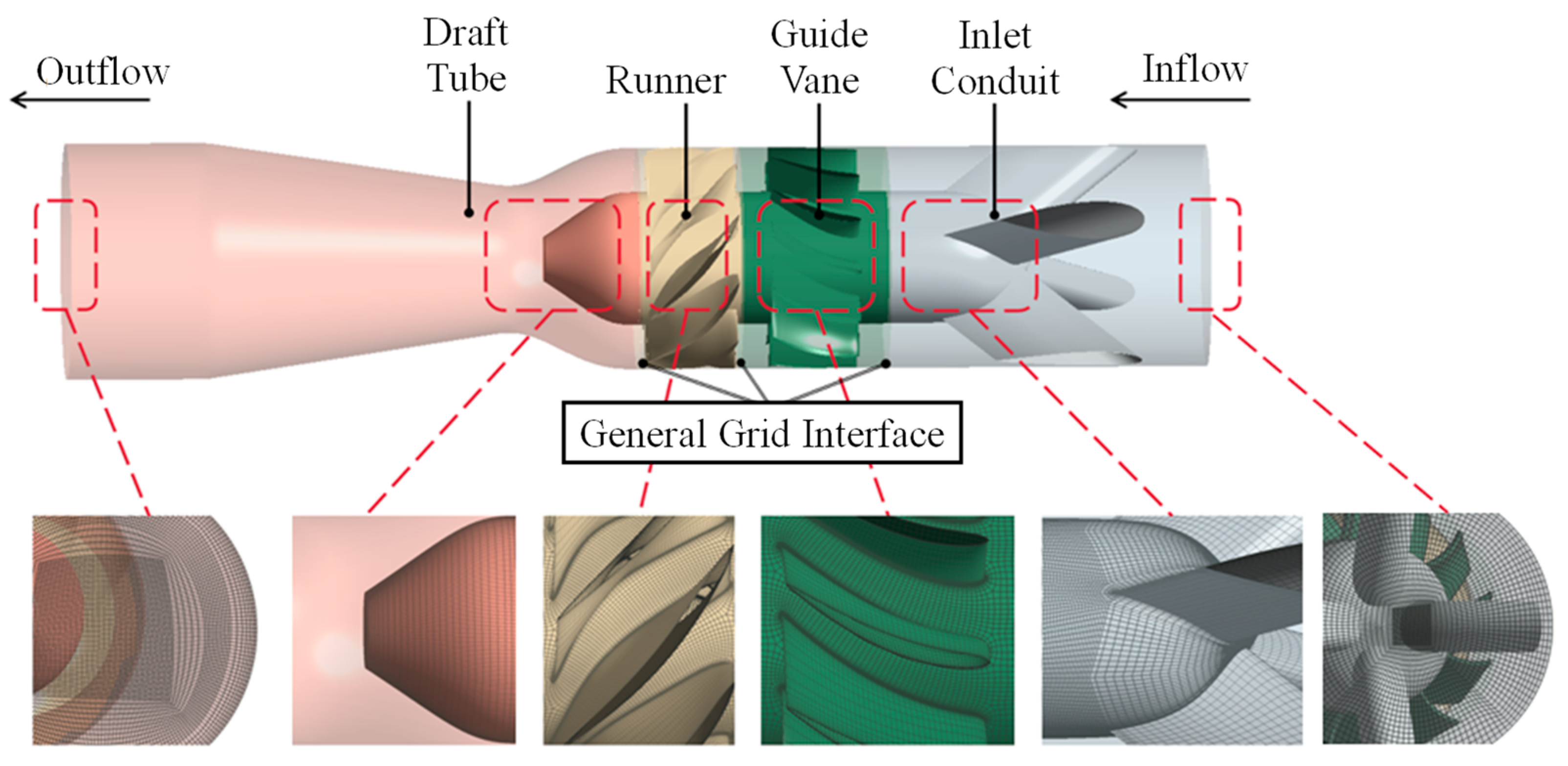
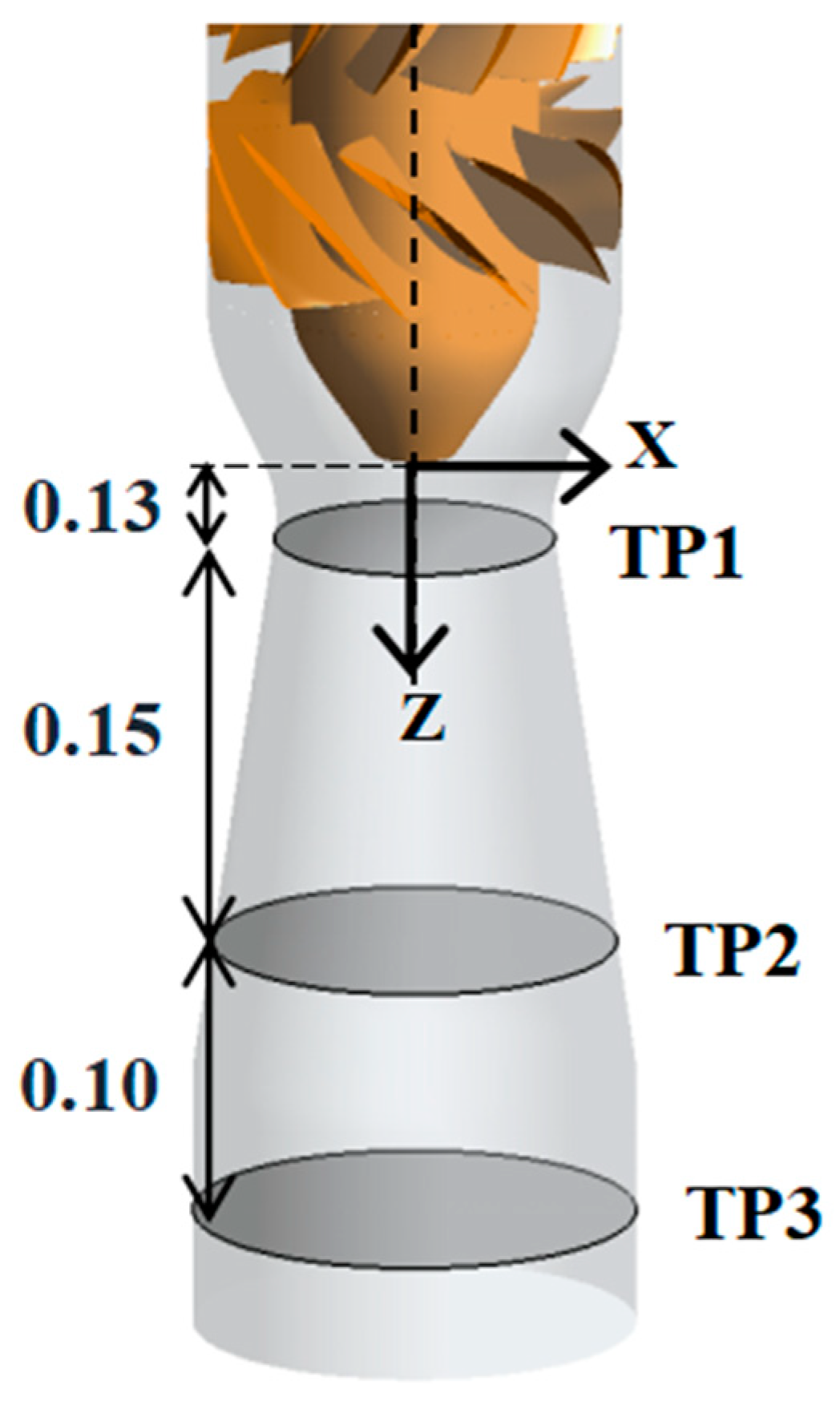
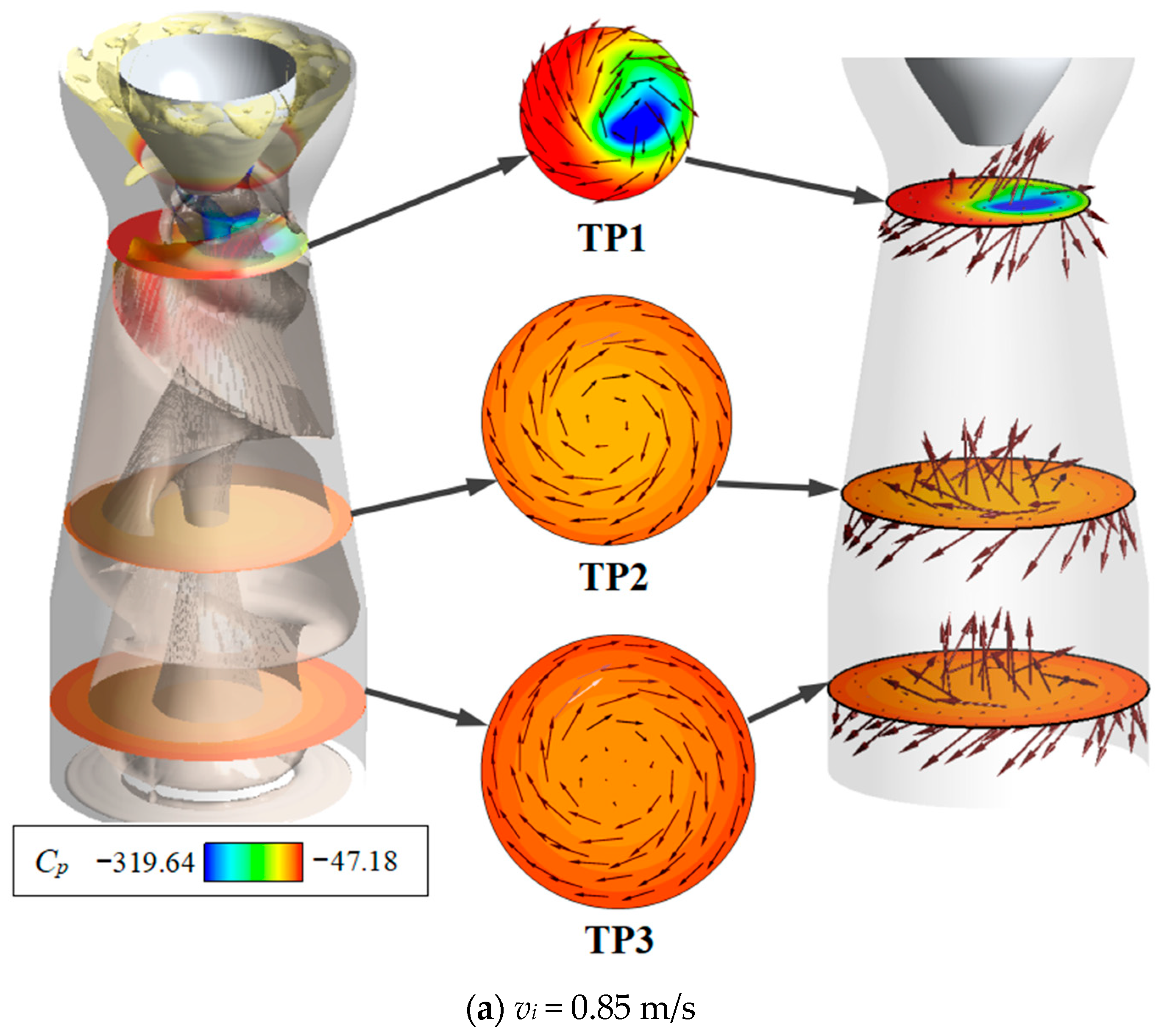
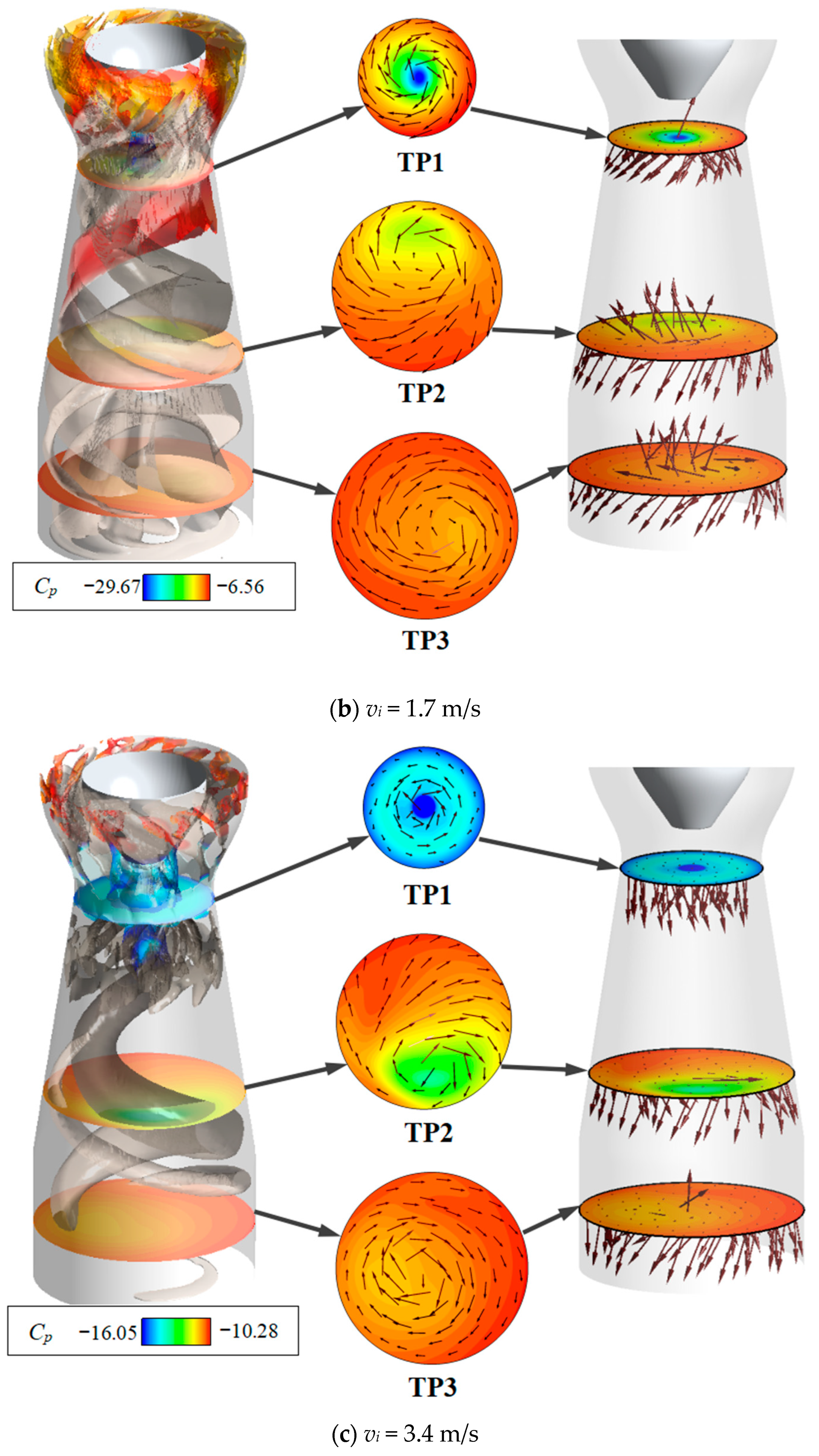
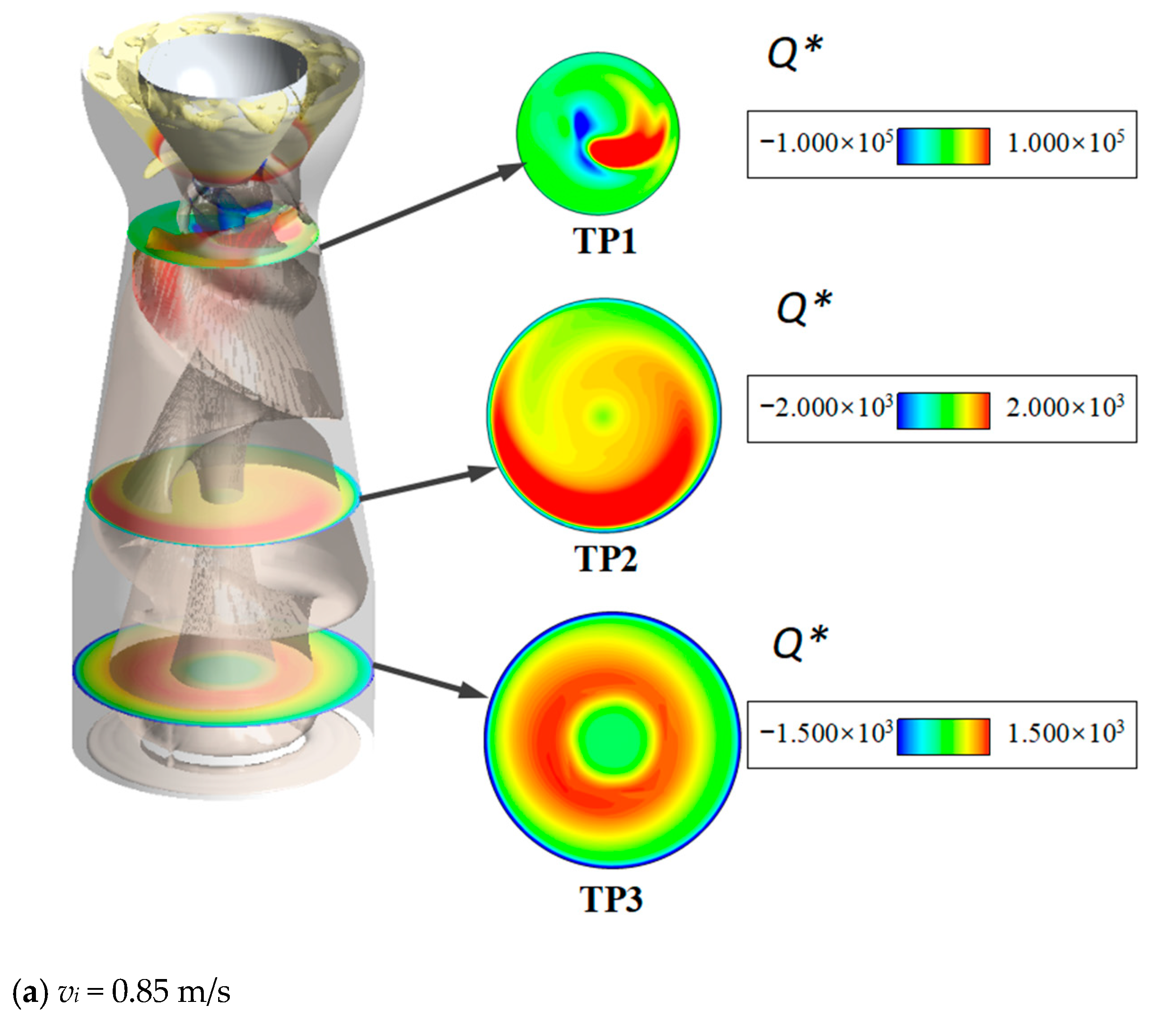
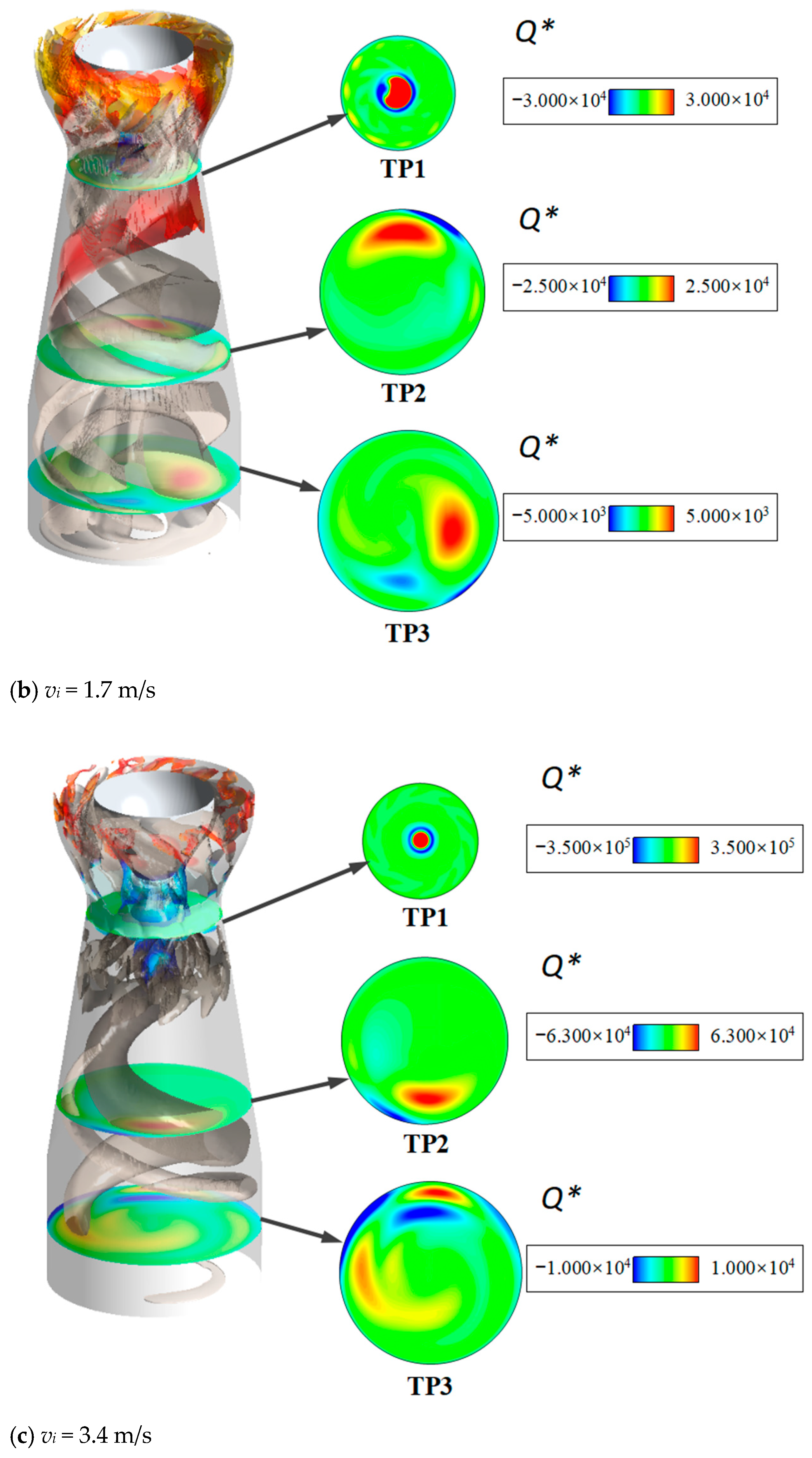
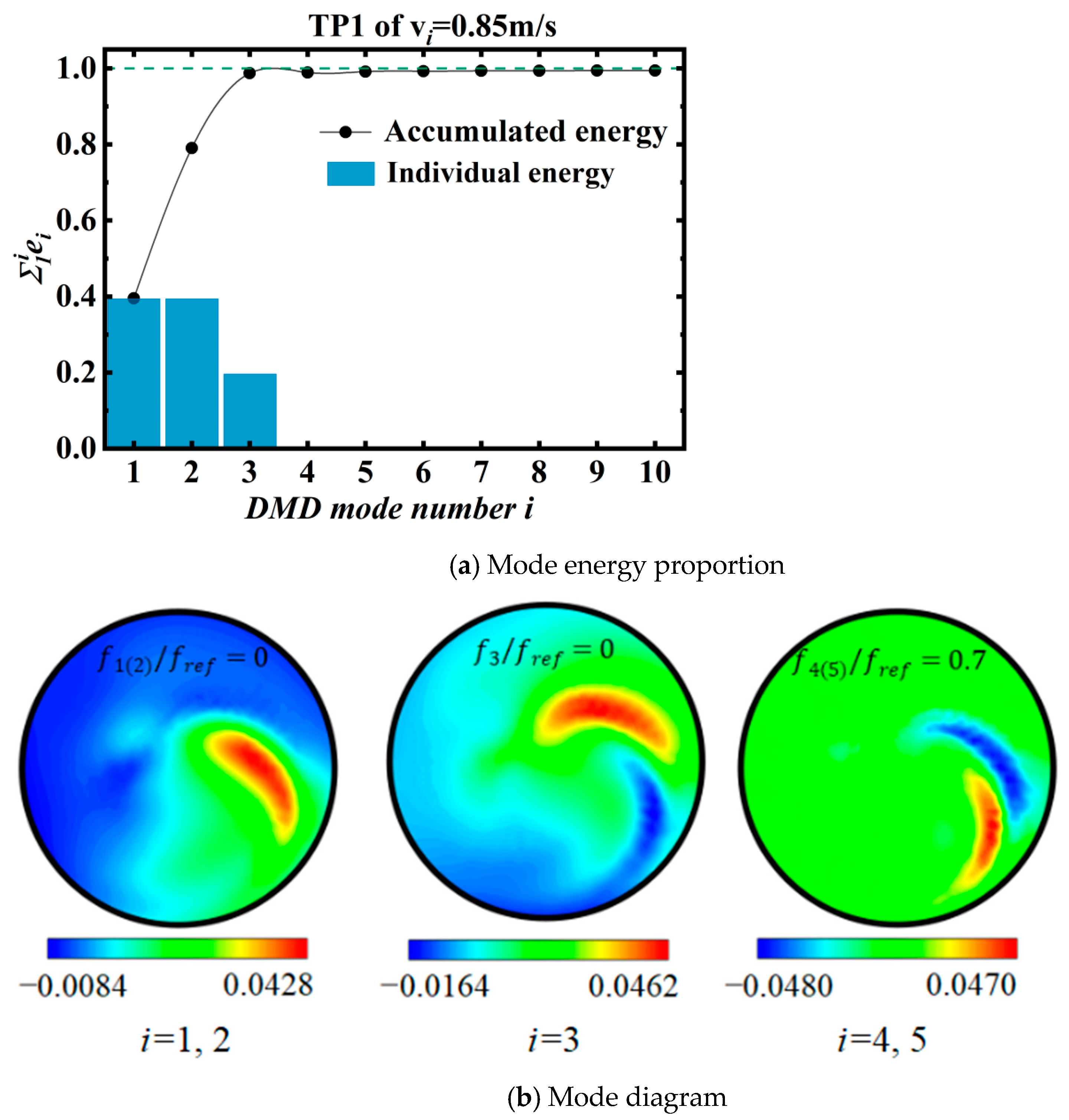


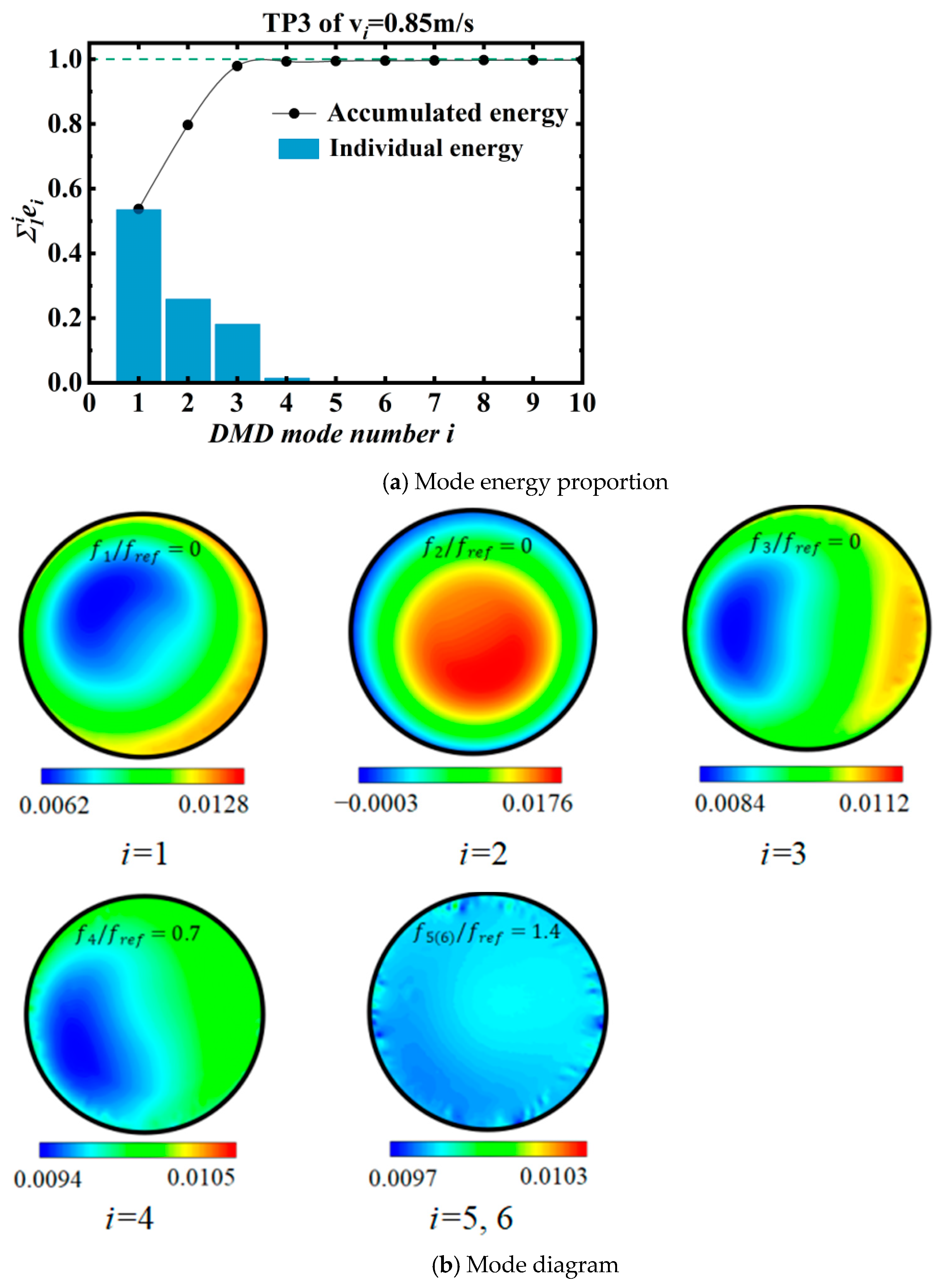
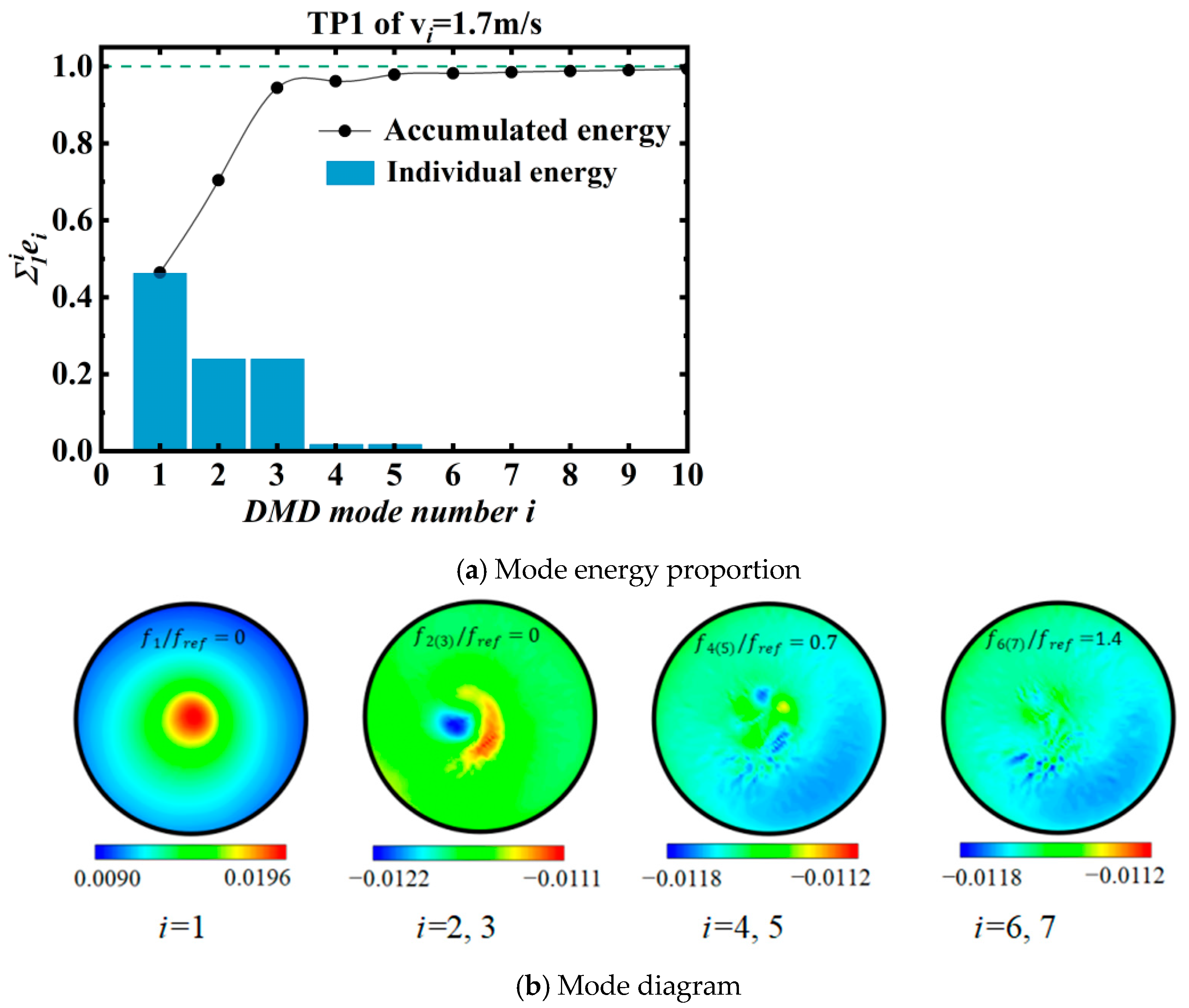

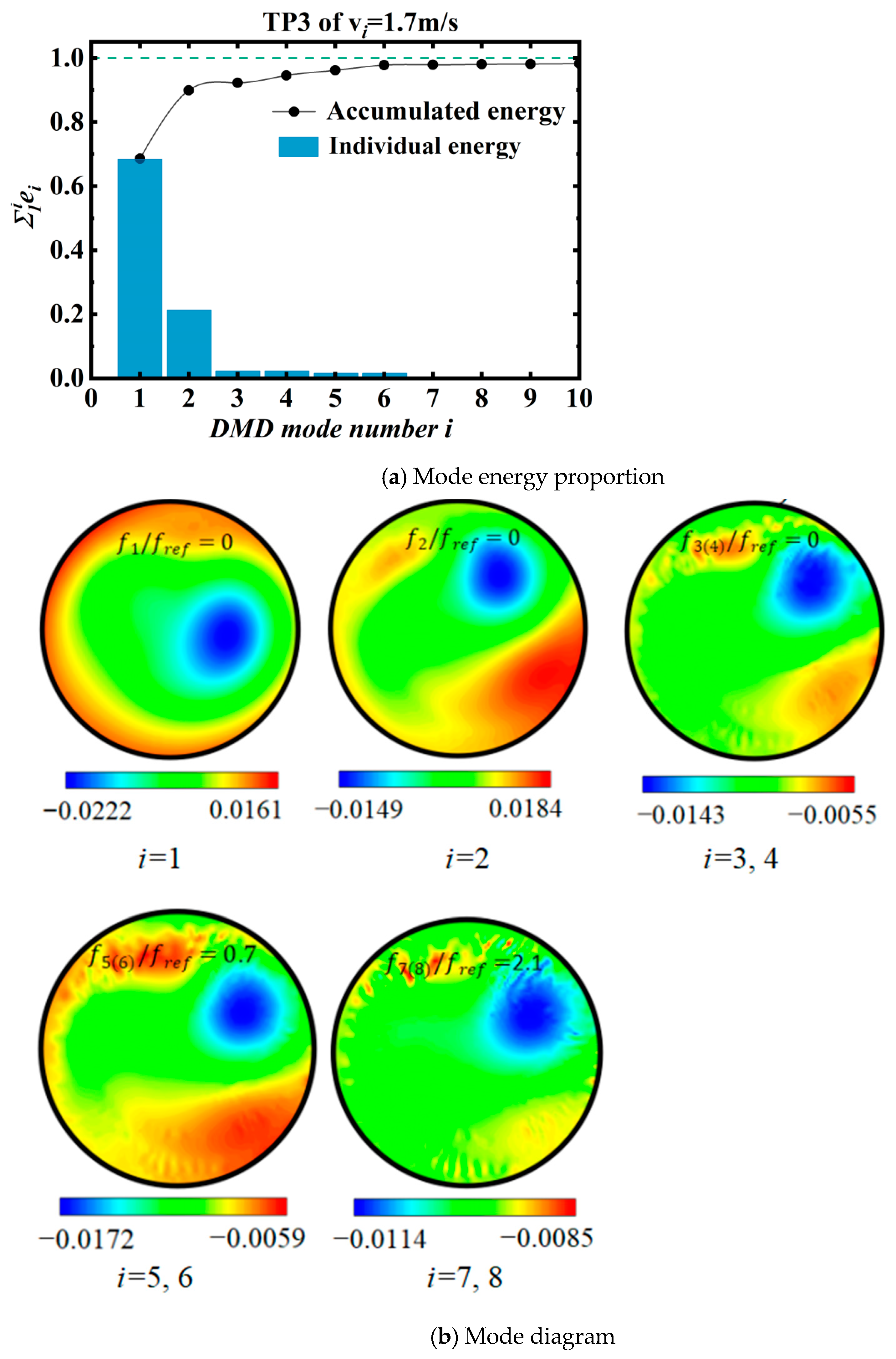
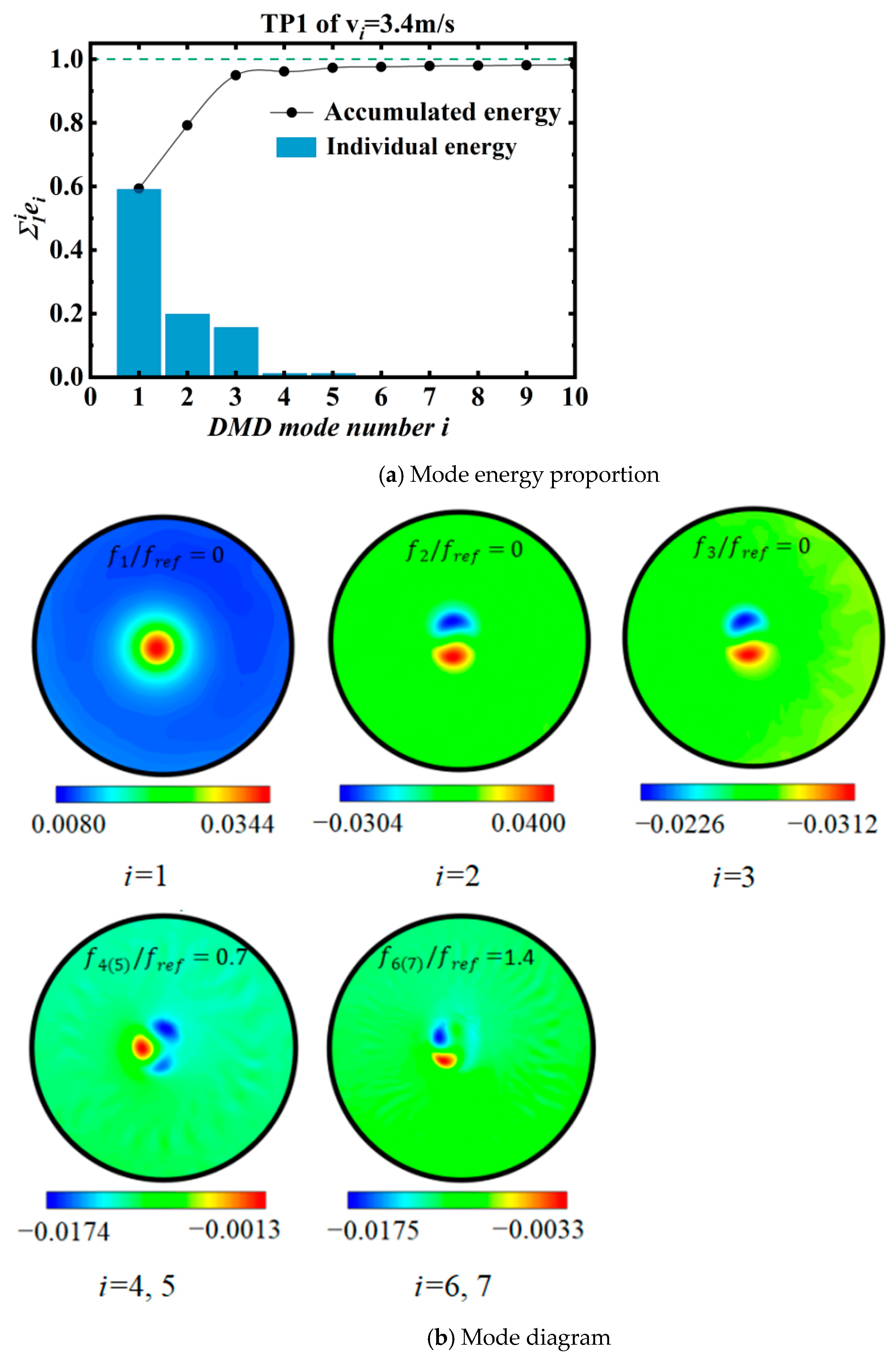
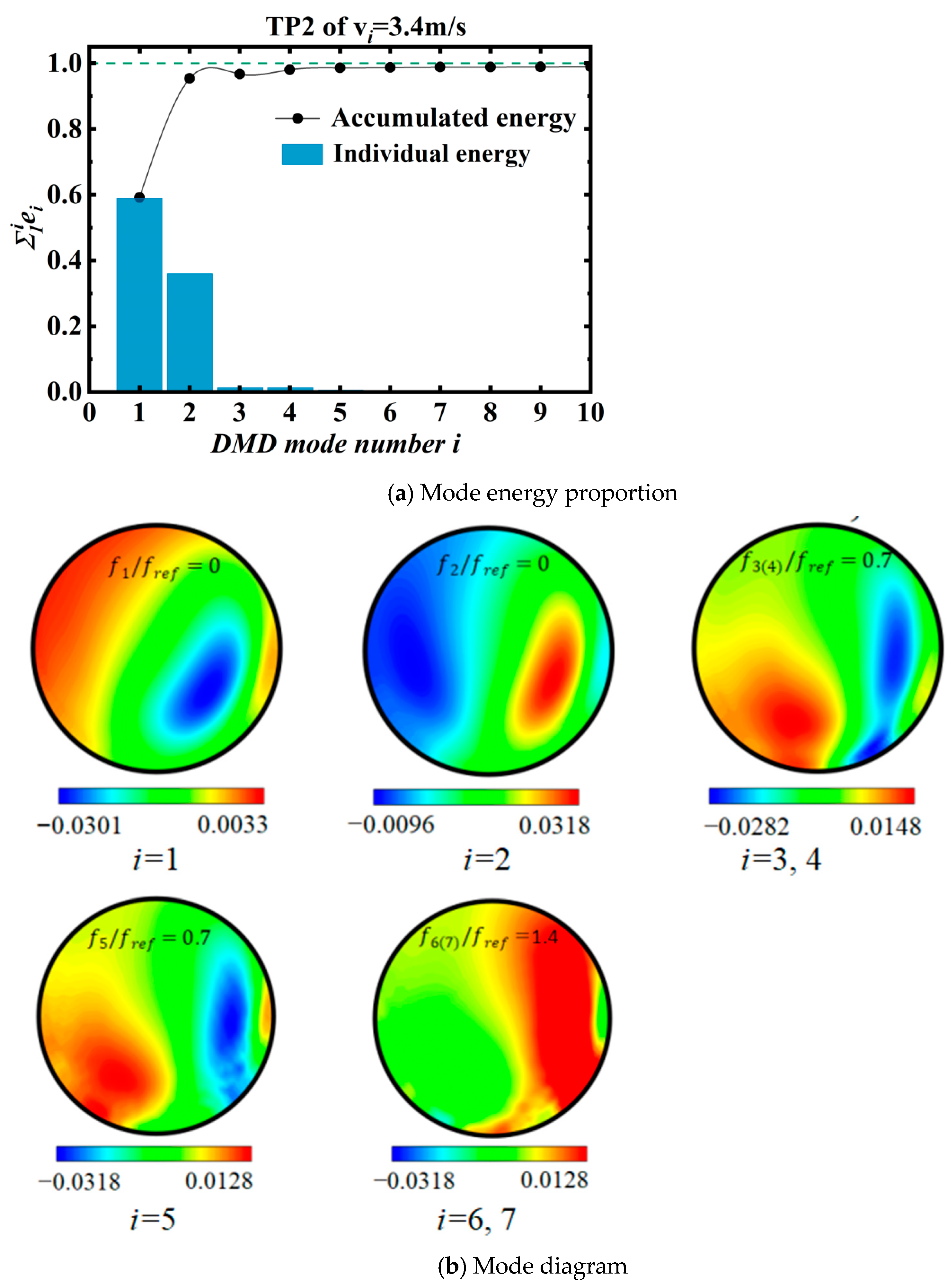
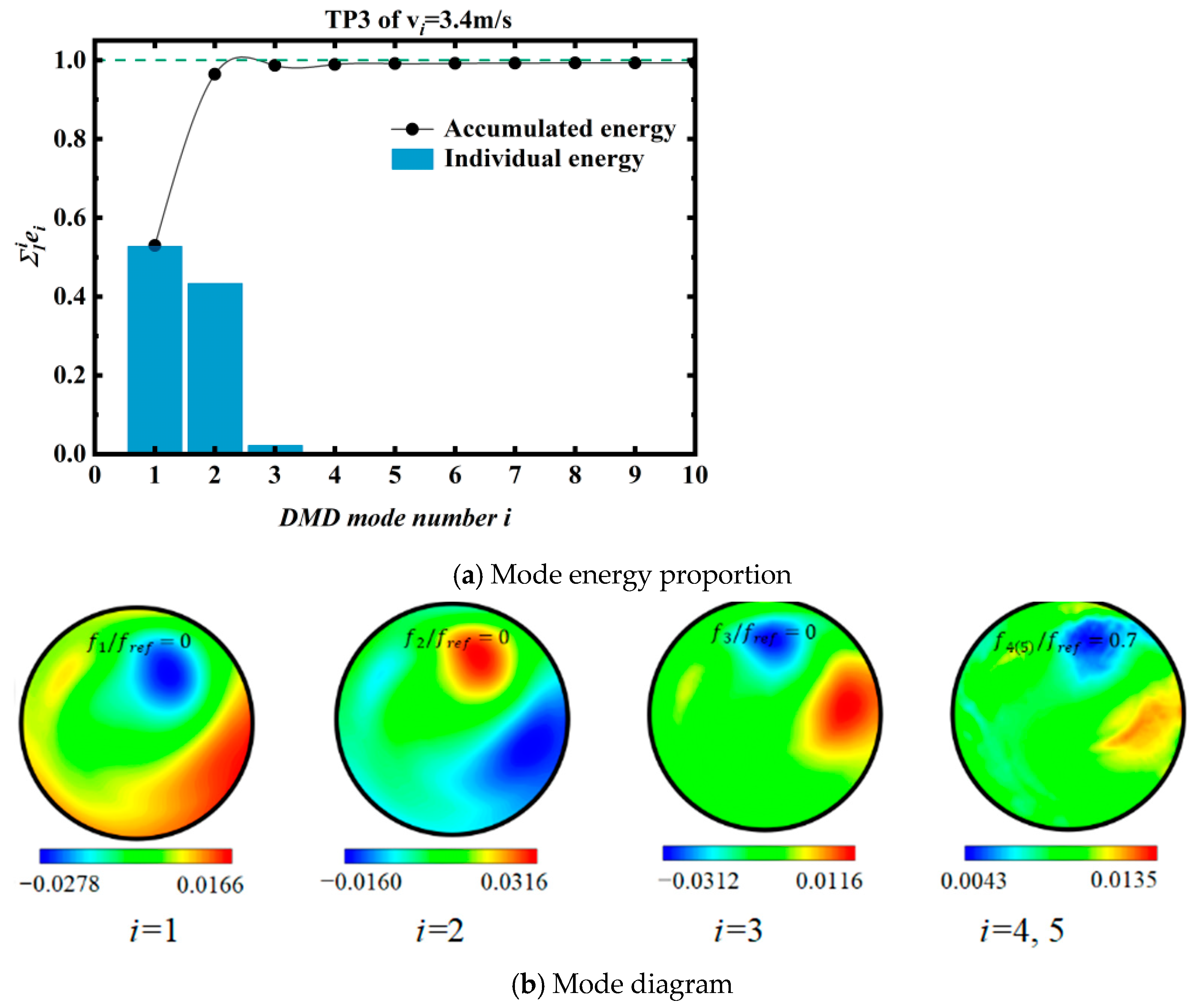
| Parameter | Symbol | Value | Unit |
|---|---|---|---|
| Flow rate | 0.015, 0.03, 0.06 | m3/s | |
| Inlet axial velocity | 0.85, 1.7, 3.4 | m/s | |
| Runner diameter | 0.15 | m | |
| Number of guide vane blades | 13 | — | |
| Number of runner blades | 10 | — | |
| Runner speed | 20 | r/min | |
| Reynolds number | Re | 126,740, 253,479, 506,958 |
| Domains | Element Number |
|---|---|
| Draft tube | 5,056,300 |
| Runner | 546,250 |
| Guide vane | 636,025 |
| Inlet conduit | 284,307 |
| Total | 6,522,882 |
| /(m/s) | 0.85 | 1.7 | 3.4 |
|---|---|---|---|
| TP1 | 0.923 | 0.779 | 4.395 |
| TP2 | 0.868 | 0.587 | 2.042 |
| TP3 | 0.352 | 0.612 | 1.555 |
Disclaimer/Publisher’s Note: The statements, opinions and data contained in all publications are solely those of the individual author(s) and contributor(s) and not of MDPI and/or the editor(s). MDPI and/or the editor(s) disclaim responsibility for any injury to people or property resulting from any ideas, methods, instructions or products referred to in the content. |
© 2024 by the authors. Licensee MDPI, Basel, Switzerland. This article is an open access article distributed under the terms and conditions of the Creative Commons Attribution (CC BY) license (https://creativecommons.org/licenses/by/4.0/).
Share and Cite
Li, S.; Guang, W.; Yang, Y.; Li, P.; Xiao, R.; Zhu, D.; Jin, F.; Tao, R. A Comparative Study of the Mode-Decomposed Characteristics of the Asymmetricity of a Vortex Rope with Flow Rate Variation. Symmetry 2024, 16, 416. https://doi.org/10.3390/sym16040416
Li S, Guang W, Yang Y, Li P, Xiao R, Zhu D, Jin F, Tao R. A Comparative Study of the Mode-Decomposed Characteristics of the Asymmetricity of a Vortex Rope with Flow Rate Variation. Symmetry. 2024; 16(4):416. https://doi.org/10.3390/sym16040416
Chicago/Turabian StyleLi, Shujing, Weilong Guang, Yang Yang, Puxi Li, Ruofu Xiao, Di Zhu, Faye Jin, and Ran Tao. 2024. "A Comparative Study of the Mode-Decomposed Characteristics of the Asymmetricity of a Vortex Rope with Flow Rate Variation" Symmetry 16, no. 4: 416. https://doi.org/10.3390/sym16040416







